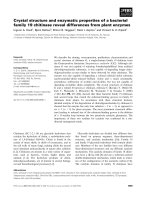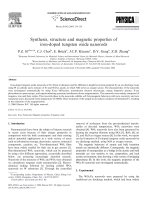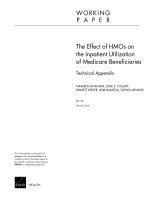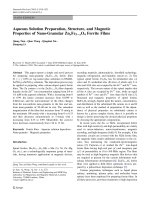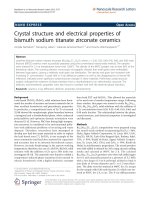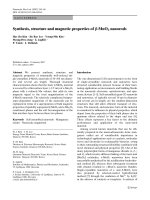The effect of residual la on crystal structure and magnetic properties of La1+ơFe11.05Si1.95 Compounds
Bạn đang xem bản rút gọn của tài liệu. Xem và tải ngay bản đầy đủ của tài liệu tại đây (755.51 KB, 6 trang )
VNU Journal of Science: Mathematics – Physics, Vol. 36, No. 3 (2020) 100-105
Original Article
The Effect of Residual La on Crystal Structure and Magnetic
Properties of La1+Fe11.05Si1.95 Compounds
Vuong Van Hiep1, Do Thi Kim Anh1,*, Ngac An Bang1, Sai Cong Doanh1,
Nguyen Duy Thien1, Huynh Dang Chinh2, Pham Duc Hanh3
1
Faculty of Physics, VNU University of Science, 334 Nguyen Trai, Thanh Xuan, Hanoi, Vietnam
Department of Inorganic Chemistry, Hanoi University of Technology, 1 Dai Co Viet, Hanoi, Vietnam
3
Vietnam Institute for Building Science and Technology, 81 Tran Cung, Nghia Tan, Hanoi, Vietnam
2
Received 16 June 2020
Revised 04 July 2020; Accepted 15 July 2020
Abstract: In this paper, we present the results of the study of the effect of residual La on crystal
structure, magnetic properties of La1+Fe11.05Si1.95 ( = 0.00; 0.03; 0.06 and 0.09) compounds. The
analysis of X-ray diffractions showed that when the La content increases to 9%, the structure still
remains cubic in a typical NaZn13 arrangement with unchanged lattice constant (about 0.5%). All
compounds exihibit ferromagnetic – paramagnetic phase transitions. The Curie temperature TC
increases slightly from 235 to 245 K.
Keywords: NaZn13-type cubic structure, Magnetocaloric materials.
1. Introduction
Potential materials applicable in magnetic cooling due to low cost, simple fabrication technology
and large magneto-caloric effect (MCE) such as Gd5(Si1-xGex)4 [1], MnAs, MnFe(P1-xAsx) [2], Heusler
alloys Ni-Mn-Ga [3], perovskite ABO3 [4], ... have attracted the attebtion of many research groups in
the world. The LaFe13-xSix compounds with NaZn13 type cubic structure is the one of these materials.
Recently, a number of studies on structure, and magnetic properties of NaZn13-type compounds
have been published [5-10]. After crystallization, the LaFe13-xSix compounds exihibit the cubic
structure of NaZn13 type with 1 ≤ x ≤ 2.6; Ce2Ni17Si13 tetrahedra structure with 3.2 ≤ x ≤ 5; and both
above types for 2.6 ≤ x ≤ 3.2 [11]. The Fe: Si ratio affects not only the crystal structure but also the
________
Corresponding author.
Email address:
https//doi.org/ 10.25073/2588-1124/vnumap.4556
100
V.V. Hiep et al. / VNU Journal of Science: Mathematics – Physics, Vol. 36, No. 3 (2020) 100-105
101
Curie temperature TC and MCE of LaFe13-xSix compounds. Most studies have found that when Si
concentration increases, the Curie temperature increases and the MCE decreases [12]. The giant
thermal effect (GMCE) in LaFe13 xSix compound is derived from the first order phase transition
(FOPT) was found only with Si content x ≤ 1.6 while the nature of phase transition is the second order
with x > 1.6 [12-14]. The magnetic and MCE properties of LaFe13-xSix compounds are also affected by
Fe replacement with other elements such as Mn and Co. The presence of Mn and Co plays different
roles in changing magnetic and thermal properties. The value of TC decreased and MCE changed
insignificantly when Fe was replaced by Mn [15]. On the other hand, when Fe was replaced by Co, the
TC value increased and MCE significantly reduced [16]. The replacement of La by other rare earth
elements such as Pr, Nd, Ce, Er resulted that the Curie temperature decreased but the MCE increased
slightly [17-19]. During the sample preparation process, a small amount of La usually evaporates due
to its low melting point. Therefore, in order to stabilize the structure, and reduce the formation of -Fe
phase, a small surplus of La is added to compensate for the evaporated portion of La.
In this report, we present the effect of residual La on the structure and magnetic properties of the
LaxFe11.05Si1.95 compounds.
2. Experiment
The La1+Fe11.05Si1.95 ( = 0.00; 0.03; 0.06 and 0.09) compounds were prepared from the precursor
materials consisting of purified metallic elements (La, R 99.9%; Fe 99.99%; Si 99.999%) by using
arc-melting method in argon atmosphere with pressure P = 105 Torr. The weight of La is compensated
by 2% surplus due to the volatile nature of the melting process. After being melted, all samples were
heated by inserting into a quartz tube, vacuumed at 10-5 Torr and then sealed. The samples were
incubated at 1100 oC for 7 days. After removing from the incubator, the samples were immediately
subjected into ice warter. The crystal structure of samples were studied by X-ray diffractometer with
Cu-K radiation of wavelength λ = 1.54056 Å at room temperature. Magnetic properties were
measured by SQUID system in temperature range from 4 to 300 K and a magnetic field of 70 kOe.
(953)
(862)
(931)
(860)
(800)
(820)
(822)
(622)
(840)
(842)
(444)
(640)
(642)
(531)
La1+Fe11,05Si1,95
(600)
(620)
−Fe
(400)
(222)
(220)
Intensity (a.u.)
8000
(420)
10000
(422)
3. Results and Discussion
6000
= 0.09
= 0.06
4000
= 0.03
2000
= 0.00
0
20
25
30
35
40
45
50
55
60
65
70
75
80
85
90
95
100
2 theta (deg.)
Figure 1. X-ray diffraction patterns of La1+Fe11.05Si1.95 compounds.
102
V.V. Hiep et al. / VNU Journal of Science: Mathematics – Physics, Vol. 36, No. 3 (2020) 100-105
Figure 1 shows the XRD patterns of La1+Fe11.05Si1.95 ( = 0.00; 0.03; 0.06 and 0.09) at room
temperature. As seen, the all diffraction peaks of all samples completely coincide with the peaks of
NaZn13 structure. This means that the samples are crystallized in a cubic space group Fm3c. However,
the compounds with residual La of 9% content have not only the main phase 1:13 but also a small
amount of the secondary α-Fe phase.
11.465
La1+Fe 11,05Si1,95
Lattice constants a
11.460
aRwDs
11.455
aRwZ−Ds
11.450
aR
11.445
11.440
0.98
1.00
1.02
1.04
1.06
1.08
1.10
1.12
La excess (x)
Figure2. Dependence of the lattice constant on La in La1+Fe11.05Si1.95 compounds.
To study the effect of diffraction angle on lattice constant in La1+Fe11.05Si1.95 compound system,
we analyzed the real lattice constant (aR), the lattice constant calculated by using the best fitting
function (aRwDs) and lattice constant derived from eliminating the error (aRwZ-Ds). These lattice
constants are investigated by a function a(x) of diffraction angle through the expression:
x = cos2/sin + cos2/. The calculation results show that when the diffraction angle increases, the
function x decreases, the value of the lattice constants increases linearly with the increase of the
function x. For all three components = 0.03; 0.06 and 0.09: corresponding to large angle (1 < x <
4), the lattice constants are almost similar, real crystal lattice constant aR and lattice constant derived
from eliminating errors aRwZ-Ds have no change when the angle changes. Only the value of the lattice
constant calculated according to the best fitting aRwDs function has a strong change compared to aR and
aRwZ-Ds with small angle (5 < x < 6). The lowest deviation is found in the compound with = 0.06. Thus,
with large angle of lattice constant values, aR, aRwZ-Ds and aRwDs are almost unchanged (Figure 2).
Table 1: Crystal lattice constant, TC phase transition temperature
and MS saturation of La1+Fe11.05Si1.95 compounds.
0.00
0.03
a = b = c (Å)
11.446 ± 0.001
0.06
0.09
11.455 ± 0.001
11.449 ± 0.001
11.449 ± 0.001
TC (K)
235 ± 1
237 ± 2
MS (B/f.u)
2.01 ± 0,01
-
236 ± 2
245 ± 1
1.95 ± 0,01
-
V.V. Hiep et al. / VNU Journal of Science: Mathematics – Physics, Vol. 36, No. 3 (2020) 100-105
103
The lattice constant of compounds La1+Fe11.05Si1.95 is recorded in Table 1. The effect of La
concentration on the lattice constant in Figure 2 show that the lattice constant of compounds with
= 1.03 and 1.09 is almost unchanged, however this value increase by 0.5% for compound with =
1.06. Thus, La deficiency concentration does not significantly affect the lattice constant of the studied
compounds.
The magnetic properties of the La1+Fe11.05Si1.95 compounds were determined through
measurements of M(T). Figure 3 shows the dependence of magnetization on the temperature for the
compounds La1+Fe11.05Si1.95 with = 0.00; 0.03; 0.06 and 0.09 at the magnetic field H = 1 kOe. The
results showed that all compounds exist phase transition from ferromagnetic state to paramagnetic
state at TC.
45
40
Magnetization (emu/g)
35
30
25
20
15
= 0,00
= 0,03
= 0,06
10
5
0
0
= 0,09
H = 1 kOe
40
80
120
160
200
240
280
Temperature (K)
Figure3. Dependence of magnetization on temperature in compounds La1+Fe11.05Si1.95 ( = 0.00; 0.03; 0.06
and 0.09) at H = 1 kOe magnetic field.
The TC Curie temperatures of compounds recorded in Table 1 show that the magnitude of TC is
almost unchanged when the added amount of La is less than 9%. However, when the residual La is
9%, the TC temperature rises 10 K, and the presence of small amounts of -Fe phase (as indicated in
the results of X-ray diffraction measurements) raises the paramagnetic background higher than that of
other compounds.
The change of TC transition temperature due to increased residual La by 9% can be explained by
molecular field model. Because La is a rare-earth type, the coefficient of molecular field nFe-Fe of
transition metal Fe is given by the formula:
𝑛Fe−Fe =
𝑇Fe
𝐶Fe
(1)
Where CFe is the Curie constant of Fe calculated by:
𝐶Fe =
2
4𝑁Fe 𝑆 ∗ (𝑆 ∗ +1)𝜇𝐵
3𝑘B
(2)
104
V.V. Hiep et al. / VNU Journal of Science: Mathematics – Physics, Vol. 36, No. 3 (2020) 100-105
Where TFe is the temperature of the transition metal Fe and here TFe = TC, kB is Boltzmann's
constant, NFe is the number of Fe atoms per mole. The effective magnetic moment of Fe in the
paramagnetic state is defined as 2 [S*(S* + 1)]1/2 = 3.5 μB. When the concentration of La increases to a
certain extent, the disorder of the compound increases, the distance of Fe-Fe interaction increases, the
nFe-Fe molecular field coefficient increases that leads to the increase of Curie temperature TC.
2.4
= 0,00
= 0,06
2.0
M (Fe)
1.6
1.2
0.8
0.4
T = 1.8 K
0.0
0
20
40
60
80
H (kOe)
Figure 4. The magnetization isotherms for the La1+Fe11.05Si1.95 compounds
( = 0.00 and 0.06) at T = 1.8 K.
Figure 4a displays the magnetization isotherms for the La1+Fe11.05Si1.95 compounds ( = 0.00 and
0.06) at T = 1.8 K. Note that both samples have the saturation magnetization values at 0H = 10 kOe
and this value changes about 3% that is quite close to the magnetic moment of Fe to 2.2 B/f.u.
4. Conclusion
Successfully fabricated La La1+Fe11.05Si1.95 ( = 0.00; 0.03; 0.06 and 0.09). After being annealed,
the samples existedt the phase with cubic structure of NaZn13 (1:13) of Fm3c space group and a small
fraction of α-Fe phase. When the amount of La residual increases to 9%, the compound still exists
structure 1:13 and the lattice constant is not significantly changed (about 0.5%), whereas the Curie
temperature TC slightly increases from 235 K to 245 K. Therefore, this alloy can be a candidate for
magnetic refrigerant at the corresponding temperature range.
Acknowledgments
This research is funded by Vietnam National Foundation for Science and Technology
Development (NAFOSTED) under grant number 103.02 -2017.326.
V.V. Hiep et al. / VNU Journal of Science: Mathematics – Physics, Vol. 36, No. 3 (2020) 100-105
105
References
[1] V.K. Pecharsky, K.A. Gschneidner, Tunable magnetic regenerator alloys with a giant magnetocaloric effect for
magnetic refrigeration from ∼20 to ∼290 K, Appl. Phys. Lett. 70 (1997) 3299 -3303.
/>[2] O. Tegus, E. Bruck, K. H. J. Buschow, and F. R. de Boer, Transition-metal-based magnetic refrigerants for roomtemperature applications, Nature (London) 415 (2002) 150-156. https:// doi.org/10.1038/415150a.
[3] J. Marcos, A. Planes, L. Mañosa, F. Casanova, X. Batlle, A. Labarta, and B. Martínez, Magnetic field induced
entropy change and magnetoelasticity in Ni-Mn-Ga alloys, Phys. Rev. B 66 (2002) 224413.
/>[4] Z. B. Guo, Y. W. Du, J. S. Zhu, H. Huang, W. P. Ding, and D. Feng, Large Magnetic Entropy Change in
Perovskite-Type
Manganese
Oxides,
Phys.
Rev.
Lett.
78
(1997)
11421145. />[5] A. Fujita, K. Fukamichi, J.T. Wang, Y. Kawazoe, Large magnetovolume effects and band structure of itinerantelectron
metamagnetic
compounds, Phys.
Rev.
B 68 (2003) 104431. />[6] J. Lyubina, K. Nenkov, L. Schultz, O. Gutfleisch, Multiple Metamagnetic Transitions in the Magnetic Refrigerant
Phys. Rev. Lett. 101 (2008) 177203. />[7] A.K. Pathak, B.R. Gautam, I. Dubenko, M. Khan, S. Stadler, and N. Ali, Phase transitions and magnetoresistance
in Heusler alloys J. Appl. Phys. 103, 07F315 (2008). />[8] M.X. Zhang, J. Liu, C. He, A.R. Yan, Novel microstructure and large magnetocaloric effect in
La2Fe11Si2 magnetic refrigerant Mater. Lett. 134 (2014) 87-90. />[9] J.J. Ipus, J.M. Borrego, L.M. Moreno-Ramírez, J.S. Blázquez, V. Franco, A. Conde, Grinding and particle size
selection as a procedure to enhance the magnetocaloric response of La(Fe,Si) 13 bulk
samplesIntermetallics 84 (2017) 30-34. />[10] Van Hiep Vuong, Kim Anh Do Thi, Duy Thien Nguyen, Quang Hoa Nguyen, Nam Nhat Hoang, Physica
B 532 (2018) 115-118. />[11] M.K. Han, G.J. Miller, An Application of the “Coloring Problem”: Structure−Composition−Bonding
Relationships
in
the
Magnetocaloric
Materials
LaFe13-xSix, Inorg.
Chem. 47 (2008) 515528. />[12] O. Gutfleisch, A. Yan, K.H. Müller, Large magnetocaloric effect in melt-spun, J. Appl.
Phys. 97 (2005) 10M305. />[13] A. Fujita, S. Fujieda, K. Fukamichi, H. Mitamura, T. Goto, Itinerant-electron metamagnetic transition and large
magnetovolume
effects
in compounds Phys.
Rev.
B
65
(2001)
014410. />[14] S. Fujieda, A. Fujita, K. Fukamichi, Large magnetocaloric effect in itinerant-electron metamagnetic
compounds, Appl. Phys. Lett. 81 (2002) 1276. />[15] F. Wang, Y.F. Chen, G.J. Wang, B.G. Shen, The effect of Mn substitution in LaFe11.7Si1.3 compound on the
magnetic properties and magnetic entropy changes, J. Phys. D: Appl. Phys. 36 (2003) 301206. />[16] F.X. Hu, J. Gao, X.L. Qian, M. Ilyn, A.M. Tishin, J.R. Sun, B.G. Shen, Magnetocaloric effect in itinerant electron
metamagnetic systems, J. Appl. Phys. 97 (2005) 10M303-305. />[17] D.T.K. Anh, N.P. Thuy, N.H. Duc, T.T. Nhien, N.V. Nong, Magnetism and magnetocaloric effect in
La1−yNdy(Fe0.88Si0.12)13 compounds, J. Magn. Magn. Mater. 262 (2003) 427-431. />[18] Do Thi Kim Anh, Vuong Van Hiep, Makio Kurisu, Dinh Van Chau and Hoang Nam Nhat, Effect of Cerium
Doping on Crystal Structure and Magnetic Properties of La 1−yCeyFe11.44Si1.56 Compounds, Mat. Trans.
56(9) (2015) 1335-1338. />[19] Vuong Van Hiep, Nguyen Khac Thuan, Do Thi Kim Anh, and Hoang Nam Nhat, Crystal Structure and Magnetic
Properties of La0.8R0.2(Fe0.88Si0.12)13 (R = Sm and Tb) Compounds, Mat. Trans. 59(7) (2018) 1068-1070.
/>

